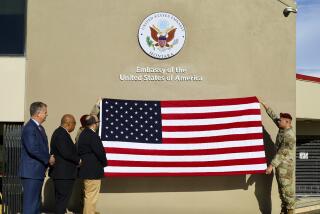Sturdier U.S. Embassy Replaces Bombed One in Kenya
- Share via
NAIROBI, Kenya — More than four years after Osama bin Laden’s terror network simultaneously attacked the U.S. embassies here and in Tanzania, American diplomats in Nairobi unveiled a fortress-like headquarters Monday designed to resist “flying bombs” like the ones that destroyed the World Trade Center.
Today, State Department officials will open another high-walled compound in Dar es Salaam, Tanzania’s commercial capital.
The two newest U.S. embassies show how the threat of terrorism has altered the architecture of America’s diplomatic missions. Unlike its predecessor, a five-story structure crammed next to high-rise buildings in a busy downtown area of Nairobi, the new 125,000-square-foot embassy here occupies a 17-acre plot in an upscale suburb north of the city, is set back more than 100 feet from the street and uses smaller amounts of glass.
“These are buildings that make a statement,” said Charles R. Stith, the former U.S. ambassador to Tanzania and now director of the African Presidential Archives and Research Center at Boston University. “They tell people like Bin Laden that the U.S. just will not be intimidated. We’re here to stay.”
U.S. officials say that three years before the Sept. 11 attacks on New York and Washington, Bin Laden’s Al Qaeda network targeted the two embassies in East Africa, killing at least 219 people in Nairobi and 12 in Dar es Salaam and injuring thousands more. The vast majority of the dead were Kenyans and Tanzanians.
After the attacks, Congress required that new embassies conform to specific new security standards. The four-story embassy here, the largest in sub-Saharan Africa, was the first to be built after those laws were enacted.
U.S. officials boasted Monday that the Nairobi mission is one of the most bombproof buildings in the world. The reinforced roof and walls are strong enough to survive an aircraft attack such as the one that leveled the World Trade Center, they said.
Special windows will not shatter even from a blast of 1,000 pounds of explosives -- the same amount contained in a car bomb that buckled the walls of the old Nairobi embassy and collapsed an adjacent office building.
If the windows did break, the 3-inch-thick glass is laminated with a coating that would force it to crack into large chunks, not shards.
In the 1998 bombing, glass shattered into tiny daggers that sprayed the faces of people near windows in nearby office buildings. More than 100 people were totally or partially blinded.
A moat, about 30 feet wide in some places, separates the embassy from the walls of a neighborhood shopping center. Giant electrical generators and a 100,000-gallon water tank, which is buried in an undisclosed location beneath the grounds, will protect embassy staffers from the recurring power and water shortages that afflict ordinary Kenyans.
Bill Prior, the State Department project manager who oversaw the construction, said the building’s ventilation system was designed to withstand a biological attack. When the embassy doors swing open, air whooshes out as if propelled by a powerful fan.
“This thing is like a fortress,” Prior said. “We basically realized [the terror threat that’s] out there and built something to sustain us.”
U.S. Marines will be among the 100 security officers who will guard the building.
President Bush was supposed to open the Nairobi embassy on a trip to Africa that he canceled a few months ago.
U.S. Undersecretary of State for Management Grant Green officially opened the building, describing it as “a permanent and living memorial, a triumph of hope and steadfast determination in the face of evil and intolerance.”
In a brief ceremony, Green and U.S. Ambassador to Kenya Johnnie Carson dedicated a small stone obelisk to the memory of the 46 people -- 12 of them Americans -- who died inside the embassy in the 1998 bombing.
Some Kenyan bomb victims complained that they were not invited to the ceremony, while some local residents complained that the embassy does not have a parking lot for the noisy matatus, or minivan taxis, that each week will bring thousands of visa seekers.
Prior said designers excluded a parking lot because they didn’t want to encourage terrorists or asylum seekers.
“We don’t have bunkers [and] we don’t have a fortress,” said Paula Herr, an American originally from Honolulu who is a member of a local residents association that opposed the embassy’s construction. “Why did they put this building in a residential area near a shopping center and a school?”
U.S. officials say the residents’ fears are unfounded. The new embassy, they say, will be used as a model for other diplomatic missions now being built or upgraded in six other African capitals.
*
Special correspondent Driscoll reported from Nairobi and staff writer Maharaj from Los Angeles.
More to Read
Sign up for Essential California
The most important California stories and recommendations in your inbox every morning.
You may occasionally receive promotional content from the Los Angeles Times.













